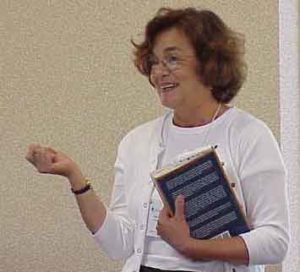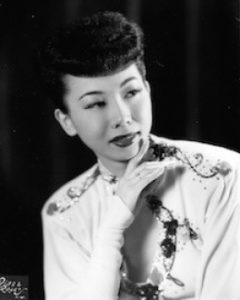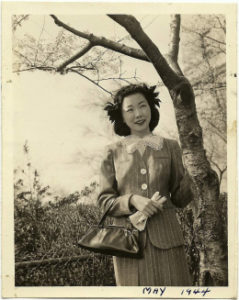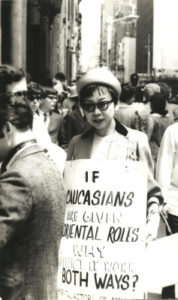Marnie Mueller Writes of Japanese American Incarceration (Ecuador)
Marnie Mueller (Ecuador 1963-65) has recently been asked by Densho.org, the preeminent website on the incarceration of Japanese Americans, to write a short biography of Mary Mon Toy. As a result of working with them on it, they have asked Marnie to digitize all of her archive on Mary Mon.
Below is a brief overview by Marnie of Mary Mon Toy’s life.
Singer and showgirl best known for her comedic role as Minnie Ho in The World of Suzie Wong on Broadway. Mary Mon Toy’s career was begun and forged after her incarceration in the Minidoka concentration camp. Her love of singing and her need to prove to herself that she had not been destroyed by what she’d been through spurred her to fulfill a youthful dream of becoming an opera singer. Like many Nisei, she reentered America with a determination to succeed.
Early Life and Wartime Incarceration
Born Mary Teruko Watanabe on June 3, 1916, she was the oldest child of Mon Yusa Watanabe, a housewife, and Yoshizo Watanabe, the first Japanese chiropractor in Washington state. Her younger brother was Frank Chusei Watanabe.
Mary Teruko graduated from Broadway High in Seattle in 1934. She attended William Business School from 1934 to 1935, where she met Shigesato Okada, who was also Nisei. As a couple, they moved in a young, up-and-coming Nisei set of politically progressive, intellectual, business-oriented, and university educated men and women who skied and played golf as recreation. They married on September 28, 1941, two months before the bombing of Pearl Harbor. On April 28, 1942, they were in the first group remanded to Puyallup Assembly Center. Transferred to Minidoka in August of 1942, her stay in camp changed the course of her life. In October of 1942, Federal marshals removed Shigesato from Minidoka and accompanied him back to Seattle to testify in a trial involving the owner of C.K. Takahashi, where he had worked as a manager. Shig was accused of traveling to Mexico in 1941, to make a transfer of scrap iron to Japan through a third party, in violation of the Trading with Enemies Act. He was acquitted of all charges and returned to camp, but remained under suspicion by the War Relocation Authority (WRA) and FBI for the duration of his incarceration. Mary, by association, was also viewed with suspicion. To compound her distress, she was hospitalized multiple times resulting in an oophorectomy, or removal of her ovaries, in the Minidoka camp hospital, thus ending any possibility of future child-bearing.
Despite the additional scrutiny she and Shig faced, Mary Teruko managed to secure their release from camp through strategic letter writing to WRA representatives and to businesses on the outside for work placement. This effort was complemented by the many letters of support she secured from Caucasians who knew them from Seattle. Granted leave clearance in the fall of 1943, she and Shig separated. She moved to New York City where she worked as a secretary while attending the Julliard School of Music to study voice. Their marriage was dissolved. She never remarried.
From Showgirl to Headliner
Informed by her teachers at Juilliard that as an Asian, she could never become an opera singer, not even in Madama Butterfly, Watanabe Okada scoured the trades for opportunities. In 1946, at thirty, she answered an audition call for “Oriental Girls, five feet six and over.” A tall woman, she was hired as a showgirl in the “Slant Eyed Scandals” at the new China Doll Club in Times Square. She dropped her Japanese name to become Mary Mon Toy, a Chinese American performer, assuming the last name of her colleague, Dorothy Toy, the famed Asian American tap dancer, who ironically was also Japanese American. They each thought the other was Chinese American.
Eight months later, Mary Mon Toy stepped forward from the chorus line to belt out a song, startling the producers with her fine voice. They upgraded her act to the “Chinese Chanteuse.” She maintained the cover of being Chinese American for the rest of her career due in great part to what she had confronted in April of 1944, soon after her arrival in New York City, when Mayor Fiorella LaGuardia launched an all-out attack on the relocation of Japanese Americans from the camps to New York. That same April she was also called before a WRA hearing in Manhattan to determine if her leave clearance would be rescinded, which it wasn’t. She confided to her friend, choreographer Emiko Tokunaga, that she was terrified she’d be sent back to the camps or expatriated to Japan.
After eight months at the China Doll Club, Mon Toy moved on to the world of white vaudeville. Often the only Asian American on the bill, she performed with puppeteers, ventriloquists, mimics, dog acts, aerial artists, and contortionists at second rate clubs; quickly she garnered solo bookings in swank venues from Florida to Montreal, Canada. By the spring of 1948 she was the top act at Boston’s Music Box club in the Copley Square Hotel. Billed as the “Oriental Songstress,” the columnists, to extol her beauty, pointed out that she was the current “Miss Slant Eyes of 1948.” She’d inoculated herself against anti-Japanese sentiment, but she still had to meet ingrained prejudice against Asians, even couched in supposed compliments.
While appearing at the Music Box, she was one of a star-studded lineup including Dorothy Lamour, Hildegarde, Eddie Foy Jr., Count Basie, and Billy Eckstine for the pre-movie live show at the premier of the Berlin Express, where she sang before the movie palace audience of four thousand.
On February 6, 1949, Mon Toy joined the choral ensemble of Kurt Weill’s American opera Street Scene, book by Elmer Rice and lyrics by Langston Hughes, at Manhattan’s Ninety-Second Street Young Men’s and Young Women’s Hebrew Association. She played the legendary Palace Theater in the summer of 1950 in a vaudeville program of eight acts where she teed off with the ballad “This Can’t Be Love,” and ended with a selection from the opera Carmen, a mix of low and high that was becoming her signature. That fall, she debuted as a regular at the Old Romanian on Manhattan’s Lower East Side, a venerable Jewish restaurant and club, recently renovated to accommodate five hundred patrons. The opening night audience included Lou Walters (Barbara Walters’ father) of the Latin Quarter.
In 1953, Mon Toy began work at Walters’ Las Vegas Desert Inn Folies Bergere. In January of 1954 she moved on to Walters’ legendary Manhattan Latin Quarter, located in Times Square, as one of a mixed Negro, white, and Asian trio, Les Mademoiselles Parisians: La Americain, a former white stripper; La Creole, a previous Cotton Club showgirl; and Mary Mon Toy as La Chinoise.
Broadway Roles and Later Career
One evening, four men sat in the Latin Quarter audience: the young author, Truman Capote; Saint Subber, a Broadway producer; Peter Brook, the English director; and Oliver Messel, a renowned British set and costume designer. They were scouting for a new Broadway musical, House of Flowers, based on a Capote novella, with music and lyrics by Harold Arlen (“Over the Rainbow”) and choreography by George Balanchine; it would be a historically groundbreaking theatrical experience with an eminent Negro cast (Pearl Bailey, Geoffrey Holder, Alvin Ailey, and Diahann Carrol to name a few). Mary Mon Toy as Mademoiselle Honolulu, and two white male actors, were the only non-black performers. The show ran for 165 performances.
Her next Broadway role was Minnie Ho in the World of Suzie Wong in 1958. The play, starring France Nuyen and William Shatner, directed by Joshua Logan, ran for 508 performances.Suzie Wong earned Mon Toy, her first appearances on television, including singing on the Jack Paar Show and a cameo on Phil Silver’s Sergeant Bilko Show. When the play closed, Mon Toy toured the country in the role she had created.
In the 1960s, 1970s, and 1980s, even as she aged-out of the gorgeous woman roles, she kept working, venturing into smaller theatrical opportunities in New York City, such as the off-Broadway play, Santa Anita ’42, set in the notorious “assembly center.” She was a regular at regional theaters, touring in South Pacific (Bloody Mary), The King and I (Lady Thiang) and Flower Drum Song (Helen Chao). She did voice-over and on-screen television ads. She appeared on television in Nurse and One of Our Own. She was the voice of Jade Snow Wong, the writer and ceramist in the PBS-TV special, Jade Snow. During her ten-year stint in a recurring part on the soap opera Ryan’s Hope, she played Mrs. Lem, the owner of an upscale Chinese restaurant. Her dramatic television break was on the internationally popular detective series, Kojak, playing a Chinese grandmother opposite Telly Savalas in “Chinatown Murders.” She was hired for both independent and major films, notably as the nutritionist in All That Jazz.[14]
Activism
Throughout her career, Mary Mon Toy was outspoken about discrimination against Asian performers and supportive of other Asians in the arts. In 1958 while performing in Suzie Wong, she said in a newspaper interview, “A big TV show is getting ready for after the first of the year. It will have Oriental themes. Are they hiring Orientals? No. It will be as phony as a $33 diamond.” In 1968, she walked a picket line against the Yellow Face casting in a remake of The King and I at New York’s City Center. Her placard read “If Caucasians are given Oriental roles, why doesn’t it work both ways? Oriental Actors of America.” In 1986, as a member of AFTRA, the American Federation of Television and Radio Artists, she joined with actors of all races to demonstrate in solidarity with victims of apartheid.
To the end of her life she continued to mask her identity. As she rehearsed Santa Anita ’42, she didn’t divulge to the cast or the director that she had been incarcerated; intensely sensitive to discrimination, she remained fearful to completely come out as herself. It was a loss for her personally and perhaps for her career. She missed out on the support of the Japanese American community in her fight for her rightful place as an artist. But her choice to pass was not made out of cowardice, rather one of resilience, fueled by her need to go forward into the America that had betrayed her.
Mary Mon Toy died on December 7, 2009, the 68th anniversary of the Pearl Harbor attack.
Marnie Mueller, who was born in the Tule Lake Segregation Camp to Caucasian parents–Don and Ruth Elberson, members of the liberal segment of the Administration—is the author of three novels: Green Fires, set in the rainforest of Ecuador; The Climate of the Country, a story loosely based on her parents’ tenure in Tule Lake; and My Mother’s Island, which takes place in a small community in Puerto Rico where her family lived for twenty years. Mueller is the recipient of numerous awards including, an American Book Award, a Maria Thomas Award for Outstanding Fiction, Barnes and Noble “Discover Great New Writers,’ New York City Public Library, “Best Books for the Teenage,” New York Times Book Review, “New and Noteworthy in Paper.” Her novels are in-print with Northwestern University Press. A member of PEN America, the Authors Guild, and the National Books Critics Circle, she is also on the steering committee of Women Writing Women’s Lives, a professional association of women biographers and memoirists under the aegis of the Center for the Study of Women and Society and the Center for the Humanities at the Graduate Center of the City University of New York (CUNY). Her next book is In Love and Anger, a memoir/biography of her friendship with Mary Mon Toy. Marnie’s website is www.marniemueller.com




No comments yet.
Add your comment